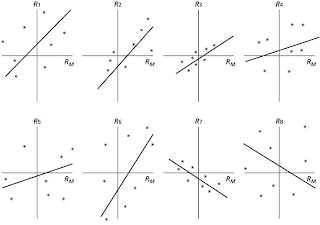Single Factor Model
βi = index of a securities’ particular return to the factor
M = unanticipated movement commonly related to security returns
Ei = unexpected event relevant only to this security
Assumption: a broad market index like the S&P500 is the common factor
Specification of a Single-Index Model of Security Returns
Use the S&P 500 as a market proxy
Excess return can now be stated as:
This specifies the both market and firm risk
Figure 6.11 Scatter Diagram for Dell
Figure 6.12 Various Scatter Diagrams
Components of Risk
Market or systematic risk: risk related to the macro economic factor or market index
Unsystematic or firm specific risk: risk not related to the macro factor or market index
Total risk = Systematic + Unsystematic
Measuring Components of Risk
si2 = bi2 sm2 + s2(ei)
where;
si2 = total variance
bi2 sm2 = systematic variance
s2(ei) = unsystematic variance
*s=std. deviation
Examining Percentage of Variance
Total Risk = Systematic Risk + Unsystematic Risk
Systematic Risk/Total Risk = p2
ßi2 s m2 / s2 = p2
bi2 sm2 / bi2 sm2 + s2(ei) = p2
Advantages of the Single Index Model
Reduces the number of inputs for diversification
Easier for security analysts to specialize




No comments:
Post a Comment